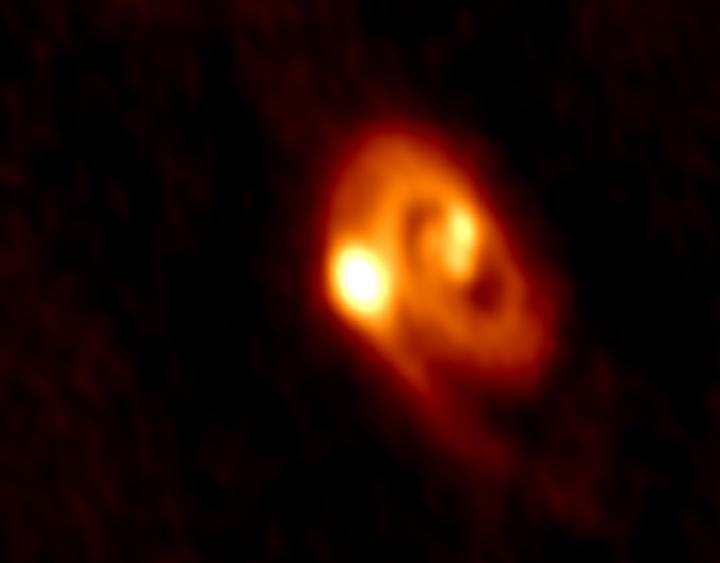OU-led team discovers rare, newborn tri-star system using ALMA

ALMA captured the image of the tri-system and the disk material around the stars and the spiral arms. The system spans a region about five times the size of our own solar system. Credit: University of Oklahoma and ALMA
John J. Tobin, professor of astrophysics in the Homer L. Dodge Department of Physics and Astronomy, OU College of Arts and Sciences, led a global team of researchers who demonstrated that the disk surrounding the tri-star system appeared susceptible to disk fragmentation.
Team members represented Leiden University, The Netherlands; University of Arizona; Chalmers University of Technology, Onsala Sweden; University of Illinois; SUNY Fredonia; University of Virginia; National Radio Astronomy Observatory, New Mexico; Max-Planck, Germany; and University of California, San Diego.
“What is important is that we discovered that companion stars can form in disk material surrounding a dominant star,” said Tobin. “We had observed this system in the past with ALMA's predecessors, but this is the first time we have been able to clearly analyze the disk and the newborn stars within it. ALMA revealed the spiral arms and disk that led to the formation of the tri-star system. Triple systems like this one are rare, and this is the only one with a configuration like this, but we are actively searching for more.”
How binary stars form has been a mystery for some time, and there are different theories about how they form–one is the fragmentation of the disk around the stars that are forming. Tobin explains the formation of the disk in which the tri-star system is forming is like a figure skater doing a spin and pulls his or her arms in to gather speed.
A star initially forms from a cloud of interstellar gas that is collapsing under its own gravity. The spin from the cloud causes a disk to form as the material spins faster and falls toward the star. If the disk happens to have enough material, spiral arms form and the disk can fragment to another star.
###
“A Triple Protostar System Formed Via Fragmentation of a Gravitational Unstable Disk,” will be published in Nature on October 27, 2016. Support for this research was provided by the Homer L. Dodge Department of Physics and Astrophysics Endowed Chair; the Netherlands Organization for Scientific Research, Grant No. 639.041.439; and the National Science Foundation, Grant No. AST-1410174. For more information about this research, contact OU Professor Tobin at jjtobin@ou.edu.
Media Contact
All latest news from the category: Physics and Astronomy
This area deals with the fundamental laws and building blocks of nature and how they interact, the properties and the behavior of matter, and research into space and time and their structures.
innovations-report provides in-depth reports and articles on subjects such as astrophysics, laser technologies, nuclear, quantum, particle and solid-state physics, nanotechnologies, planetary research and findings (Mars, Venus) and developments related to the Hubble Telescope.
Newest articles

Why getting in touch with our ‘gerbil brain’ could help machines listen better
Macquarie University researchers have debunked a 75-year-old theory about how humans determine where sounds are coming from, and it could unlock the secret to creating a next generation of more…

Attosecond core-level spectroscopy reveals real-time molecular dynamics
Chemical reactions are complex mechanisms. Many different dynamical processes are involved, affecting both the electrons and the nucleus of the present atoms. Very often the strongly coupled electron and nuclear…

Free-forming organelles help plants adapt to climate change
Scientists uncover how plants “see” shades of light, temperature. Plants’ ability to sense light and temperature, and their ability to adapt to climate change, hinges on free-forming structures in their…





















